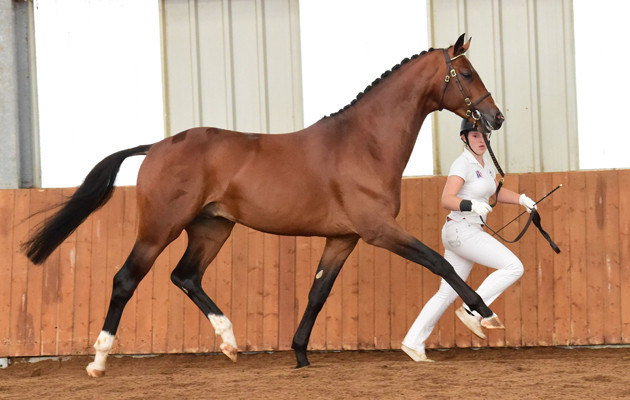A small, select band of colts are worthy of being kept entire — Andrea Oakes finds out how to tell if yours is one such gem, and if so how to manage him
If you plan to keep a colt entire for breeding purposes, it’s clear that he has to be something pretty special. But how can you tell if he really is a cut above the rest? And even if he does have the necessary wow factor, what are you letting yourself in for if you choose not to have him castrated?
Spotting stallion potential requires skill and experience, according to breeding consultant and former West Kington Stud manager Tessa Clarke, who explains that a likely candidate should stand out from the crowd at an early age.
{"content":"PHA+4oCcT2Ygc2V2ZXJhbCBtYXJlcyBhbmQgZm9hbHMgaW4gYSBmaWVsZCwgaGXigJlsbCBiZSB0aGUgb25lIHRoYXQgdGFrZXMgeW91ciBleWUs4oCdIHNoZSBzYXlzLCByZWZlcnJpbmcgdG8gdGhhdCDigJxsb29rIGF0IG1l4oCdIHByZXNlbmNlIHRoYXQgaXMgYm9ybiBhbmQgbm90IG1hZGUuIOKAnEl0IGdvZXMgd2l0aG91dCBzYXlpbmcgdGhhdCBnb29kIGNvbmZvcm1hdGlvbiBhbmQgbW92ZW1lbnQgYXJlIGtleSwgYW5kIGFyZSB1c3VhbGx5IGV2aWRlbnQgZWFybHkgb24uIEhlIGFsc28gbmVlZHMgdGhlIHJpZ2h0IHRlbXBlcmFtZW50LiBUaGlzIG1heSBjaGFuZ2UgYXMgaGUgYmVjb21lcyBtb3JlIGhvcm1vbmFsLCBhbmQgb2Z0ZW4gZGVwZW5kcyBvbiBob3cgaGUgaXMgaGFuZGxlZCwgYnV0IGFuIHVucGxlYXNhbnQgZm9hbCBpcyB1bmxpa2VseSB0byBpbXByb3ZlIHdpdGggYWdlLuKAnVRlc3NhIGVtcGhhc2lzZXMgdGhlIG5lZWQgZm9yIGFuIGhvbmVzdCBhbmQgb2JqZWN0aXZlIGFwcHJhaXNhbC4gQSBmb2FsIHdobyBpcyB0aGUgYXBwbGUgb2YgaGlzIG93bmVy4oCZcyBleWUgbWF5IG5vdCBiZSB2aWV3ZWQgd2l0aCBzdWNoIGVudGh1c2lhc20gYnkgYSB3aWRlciBhdWRpZW5jZS48L3A+CjxwPuKAnFZlcnkgZmV3IGNvbHRzIGFyZSByZWFsbHkgd29ydGggcHJlc2VydmluZyBhcyBhIHN0YWxsaW9uLOKAnSBzaGUgZXhwbGFpbnMuIOKAnEEgeW91bmdzdGVyIG11c3QgaGF2ZSBzb21ldGhpbmcgZXh0cmEsIHN1Y2ggYXMgdW51c3VhbCBibG9vZGxpbmVzLCB3aGljaCBtYXkgYmUgc2lnbmlmaWNhbnQgd2l0aCBhIG5hdGl2ZSBicmVlZCwgb3IgcmFyZSBnZW5ldGljcyBmb3IgY29sb3VyLiBIZeKAmWxsIG5lZWQgc3VjY2Vzc2Z1bCByZWxhdGl2ZXM7IGlkZWFsbHksIGJlaW5nIG91dCBvZiBhIG1hcmUgd2l0aCBhIGdvb2QgY29tcGV0aXRpb24gcmVjb3JkLiBBbmQgYXMgYSBzcG9ydCBob3JzZSBoZeKAmWxsIGJlIGV4cGVjdGVkIHRvIGJ1aWxkIGhpcyBvd24gc3VjY2VzcyBpbiBmdXR1cmUgeWVhcnMg4oCUIEJyaXRpc2ggU2hvd2p1bXBpbmcgZ3JhZGUgQiwgQnJpdGlzaCBEcmVzc2FnZSBzbWFsbCB0b3VyIG9yIEJyaXRpc2ggRXZlbnRpbmcgdGhyZWUtc3RhciwgYXQgbGVhc3QuIEdvaW5nIEJFMTAwIGlzIG5vdCBlbm91Z2gu4oCdPC9wPgo8cD5Mb3JuYSBXaWxzb24sIG9mIE5ld3RvbiBTdHVkIGluIERldm9uLCBhZGRzOiDigJxOby1vbmUgc2hvdWxkIGFpbSB0byBicmVlZCDigJhhdmVyYWdl4oCZLiBBIHN0YWxsaW9uIG11c3QgYmUgYSBzaGluaW5nIGV4YW1wbGUgb2YgY29uZm9ybWF0aW9uLCBtb3ZlbWVudCwgdHlwZSBhbmQgcGVkaWdyZWUsIGFzIGEgaG9yc2Ugc2hvdWxkIG9ubHkgYmUga2VwdCBlbnRpcmUgdG8gcHJvZ3Jlc3MgYnJlZWRpbmcgYW5kIOKAlCBpbiB0aGUgY2FzZSBvZiBzcG9ydCBob3JzZXMg4oCUIGVxdWVzdHJpYW4gc3BvcnQu4oCdPC9wPgo8cD48ZGl2IGNsYXNzPSJhZC1jb250YWluZXIgYWQtY29udGFpbmVyLS1tb2JpbGUiPjxkaXYgaWQ9InBvc3QtaW5saW5lLTIiIGNsYXNzPSJpcGMtYWR2ZXJ0Ij48L2Rpdj48L2Rpdj48c2VjdGlvbiBpZD0iZW1iZWRfY29kZS0zMSIgY2xhc3M9ImhpZGRlbi1tZCBoaWRkZW4tbGcgcy1jb250YWluZXIgc3RpY2t5LWFuY2hvciBoaWRlLXdpZGdldC10aXRsZSB3aWRnZXRfZW1iZWRfY29kZSBwcmVtaXVtX2lubGluZV8yIj48c2VjdGlvbiBjbGFzcz0icy1jb250YWluZXIgbGlzdGluZy0tc2luZ2xlIGxpc3RpbmctLXNpbmdsZS1zaGFyZXRocm91Z2ggaW1hZ2UtYXNwZWN0LWxhbmRzY2FwZSBkZWZhdWx0IHNoYXJldGhyb3VnaC1hZCBzaGFyZXRocm91Z2gtYWQtaGlkZGVuIj4NCiAgPGRpdiBjbGFzcz0icy1jb250YWluZXJfX2lubmVyIj4NCiAgICA8dWw+DQogICAgICA8bGkgaWQ9Im5hdGl2ZS1jb250ZW50LW1vYmlsZSIgY2xhc3M9Imxpc3RpbmctaXRlbSI+DQogICAgICA8L2xpPg0KICAgIDwvdWw+DQogIDwvZGl2Pg0KPC9zZWN0aW9uPjwvc2VjdGlvbj48L3A+CjxwPklmIHlvdSBmZWVsIHRoYXQgeW91ciB5b3VuZ3N0ZXIgdGlja3MgYWxsIHRoZSBib3hlcywgTG9ybmEgcmVjb21tZW5kcyBwdXR0aW5nIGhpbSB1bmRlciBjbG9zZXIgc2NydXRpbnkgaW4gYSBkaWZmZXJlbnQgc2V0dGluZy48L3A+CjxwPuKAnEEgbG90IG9mIGZvYWxzIGFyZSBib3JuIGVhY2ggeWVhciBhdCBvdXIgc3R1ZCwgc28gaXTigJlzIGVhc2llciBmb3IgdXMgdG8gY29tcGFyZSB0aGVtLOKAnSBzaGUgc2F5cy4g4oCcU29tZSBzdGFuZCBvdXQgaW1tZWRpYXRlbHkgYXMgZXh0cmVtZWx5IGhpZ2ggcXVhbGl0eS4gSWYgeW91IGhhdmUgb25seSBhIGZldywgaXTigJlzIGltcG9ydGFudCB0byB0YWtlIHRoZW0gdG8gYW4gZXZlbnQgc3VjaCBhcyB0aGUgRWxpdGUgRm9hbHMgVUsgcmVnaXN0cmF0aW9uIHRvdXIgdG8gYmVuY2htYXJrIGFuZCBhc3Nlc3MgdGhlbSBhZ2FpbnN0IG90aGVyIHNpbWlsYXJseSBicmVkIGZvYWxzLjwvcD4KPHA+4oCcQW55b25lIHRoaW5raW5nIG9mIHN0YW5kaW5nIGEgeW91bmcgc3RhbGxpb24gaXMgYWxzbyBhZHZpc2VkIHRvIHNlZSBhIHNlcmllcyBvZiBzdGFsbGlvbiBhcHByb3ZhbHMgYWNyb3NzIEV1cm9wZSwgdG8gY29tcGFyZSB0aGVpcnMgYmFjayBhdCBob21lIHdpdGggdGhlIG1hbnkgaHVuZHJlZHMgcHJlc2VudGVkLOKAnSBhZGRzIExvcm5hLiDigJxJdOKAmXMgaW1wb3J0YW50IHRvIHRha2Ugb2ZmIGFueSByb3NlLXRpbnRlZCBnbGFzc2VzIHRvIG1ha2Ugc3VyZSB0aGF0IGEgcG90ZW50aWFsIHN0YWxsaW9uIGlzIG9mIGFuIGVxdWFsIOKAlCBvciBiZXR0ZXIg4oCUIHN0YW5kYXJkLuKAnTwvcD4KPGRpdiBjbGFzcz0iYWQtY29udGFpbmVyIGFkLWNvbnRhaW5lci0tbW9iaWxlIj48ZGl2IGlkPSJwb3N0LWlubGluZS0zIiBjbGFzcz0iaXBjLWFkdmVydCI+PC9kaXY+PC9kaXY+CjxoMz5Mb2dpc3RpY3MgdG8gY29uc2lkZXI8L2gzPgo8cD5Zb3UgbWF5IHdlbGwgaGF2ZSBzb21lIGdvb2QgcmF3IG1hdGVyaWFsIHRvIHdvcmsgd2l0aCwgYnV0IHRoZXJlIGFyZSBsb2dpc3RpY3MgdG8gY29uc2lkZXIuPC9wPgo8cD7igJxTdGFsbGlvbnMgZG8gbmVlZCBleHBlcmllbmNlZCBoYW5kbGluZyzigJ0gc2F5cyBEYXZpZCBEaXhvbiwgd2hvc2Ugcm9sZSBhcyBtYW5hZ2VyIGF0IFN0YW5sZXkgR3JhbmdlIFN0dWQgaW4gTm9ydGggWW9ya3NoaXJlIGludm9sdmVzIHdvcmtpbmcgd2l0aCBzb21lIG9mIHRoZSBVS+KAmXMgbGVhZGluZyBzaXJlcywgaW5jbHVkaW5nIGFkdmFuY2VkIGV2ZW50ZXIgVXAgV2l0aCBUaGUgTGFyay4g4oCcVGhleSB2YXJ5IGEgbG90IGluIHRlbXBlcmFtZW50IGJ1dCBhcmUgdXN1YWxseSBhIHByb2R1Y3Qgb2YgdGhlaXIgZW52aXJvbm1lbnQuIEl0IGNhbiBiZSBkaWZmaWN1bHQgdG8gcHJvdmlkZSBhIHN1aXRhYmxlIGVudmlyb25tZW50IGF0IGhvbWUuPC9wPgo8ZGl2IGNsYXNzPSJhZC1jb250YWluZXIgYWQtY29udGFpbmVyLS1tb2JpbGUiPjxkaXYgaWQ9InBvc3QtaW5saW5lLTQiIGNsYXNzPSJpcGMtYWR2ZXJ0Ij48L2Rpdj48L2Rpdj4KPHA+4oCcQSBzdGFsbGlvbiB3aWxsIHJlcXVpcmUgcGxlbnR5IG9mIGV4ZXJjaXNlIGFuZCBsb3RzIG9mIGZyZWUgdGltZSBhbmQgdHVybm91dCzigJ0gZXhwbGFpbnMgRGF2aWQuIOKAnEhlIHNob3VsZG7igJl0IGJlIGNvb3BlZCB1cCAyNC83LCBvciBoZSBtYXkgZ2V0IGNyb3RjaGV0eSBhbmQgZGV2ZWxvcCBiYWQgaGFiaXRzLiBZb3XigJlsbCBuZWVkIHRoZSBmYWNpbGl0aWVzLCB0aGUgcmlnaHQgcmVnaW1lIGFuZCB0aGUgcGF0aWVuY2UsIGFuZCB5b3XigJlsbCBoYXZlIHRvIGtlZXAgeW91ciB3aXRzIGFib3V0IHlvdS4gSWYgSeKAmW0gaG9uZXN0LCBhbWF0ZXVycyBhbmQgc3RhbGxpb25zIGFyZSBub3QgYWx3YXlzIHRoZSBiZXN0IHBhaXJpbmcuPC9wPgo8cD7igJxNb3N0IGhvcnNlcyBhcmUgaGFwcGllciBnZWxkZWQs4oCdIGFkZHMgRGF2aWQuIOKAnEZpZ3VyZXMgc2hvdyBhIGdyYWRlZCBzdGFsbGlvbiByZWNlaXZlcywgb24gYXZlcmFnZSwganVzdCBmaXZlIG1hcmVzIGEgeWVhciDigJQgYW5kIHNvbWUgd2lsbCBzZWUgbm9uZS4gSXTigJlzIG5vdCB0aGUgbmljZXN0IGxpZmVzdHlsZSBmb3IgaGltIGlmIGhl4oCZcyBuZXZlciB1c2VkLuKAnTwvcD4KPGRpdiBjbGFzcz0iYWQtY29udGFpbmVyIGFkLWNvbnRhaW5lci0tbW9iaWxlIj48ZGl2IGlkPSJwb3N0LWlubGluZS01IiBjbGFzcz0iaXBjLWFkdmVydCI+PC9kaXY+PC9kaXY+CjxwPk1ha2luZyB0aGUgbnVtYmVycyBzdGFjayB1cCBpcyBhbm90aGVyIGlzc3VlLiBNYW55IHN0YWxsaW9uIG93bmVycyB3aWxsIGhvcGUgZm9yIHNvbWUgcmV0dXJuIG9uIHRoZWlyIGludmVzdG1lbnQsIGJ1dCBpcyB0aGVyZSBtdWNoIG1vbmV5IHRvIGJlIG1hZGU\/PC9wPgo8cD7igJxOb3Qgb25seSBhcmUgdGhlcmUgYXJlIGEgbG90IG9mIGdvb2Qgc3RhbGxpb25zIGluIFVLLCBidXQgYnJlZWRpbmcgaXMgbm93IGdsb2JhbCwgbWVhbmluZyB0aGF0IHRoZSBzdHVkIG1hcmtldCBpcyB2ZXJ5IGNvbXBldGl0aXZlLOKAnSBzYXlzIERhdmlkLiDigJxBIHN0YWxsaW9uIG11c3QgYmUgd29ydGggYnJlZWRpbmcgZnJvbS4gVXAgV2l0aCBUaGUgTGFyayBoYXMgYmVlbiB2ZXJ5IGJ1c3ksIGJ1dCBoZeKAmXMgMjAgdGhpcyB0aW1lIGFuZCBoaXMgbWFyZSBudW1iZXJzIGhhdmUgZHJvcHBlZCBmcm9tIGEgcGVhayBvZiA3NiB0byBhcm91bmQgMzYgYXMgb3RoZXIgc3RhbGxpb25zIGhhdmUgY29tZSBhbG9uZy48L3A+CjxwPuKAnFRoaW5rIGFib3V0IHdoZXJlIHlvdeKAmWxsIHN0YW5kIHlvdXIgc3RhbGxpb24gb3Igd2hldGhlciB5b3XigJlsbCBvcHQgZm9yIGEgd2Fsay1pbiBzZW1lbiBjb2xsZWN0aW9uIHNlcnZpY2UsIGNvbnNpZGVyaW5nIGJvdGggdGhlIGNvc3RzIGFuZCBob3cgdGhpcyB3aWxsIGZpdCBpbiB3aXRoIHlvdXIgbGlmZXN0eWxlLOKAnSBoZSBhZGRzLiDigJxGb3Igc2VtZW4gY29sbGVjdGlvbiBvbiBzaXRlLCB5b3XigJlsbCBuZWVkIHRvIG1ha2UgaGltIGF2YWlsYWJsZSBhcyBhbmQgd2hlbiBuZWNlc3NhcnkgdGhyb3VnaG91dCB0aGUgc2Vhc29uLiBXaGlsZSBuYXR1cmFsIGNvdmVyIGNhbiB0YWtlIHBsYWNlIGF0IGFueSB0aW1lIG9mIHRoZSBkYXksIGNoaWxsZWQgc2VtZW4gZm9yIEFJIG11c3QgYmUgcmVhZHkgZm9yIHRoZSBwb3N0IG9yIGNvdXJpZXIg4oCUIHdoaWNoIG1ha2VzIHRoaXMgb3B0aW9uIGEgd2F5IG9mIGxpZmUgcmF0aGVyIHRoYW4ganVzdCBhIGhvYmJ5LuKAnTwvcD4KPHA+SXTigJlzIHdvcnRoIHJlbWVtYmVyaW5nIHRoYXQgbW9zdCBvZiB0aGUgYnJlZWRpbmcgY29zdHMgYXJlIGZpeGVkLCByZWdhcmRsZXNzIG9mIHRoZSBzdGFsbGlvbuKAmXMgcG9wdWxhcml0eSBhbmQgc3R1ZCBmZWUuIEZhY3RvciBpbiBleHRyYXMsIHN1Y2ggYXMgdmV0ZXJpbmFyeSBleHBlbnNlcyBmb3IgdGhlIGFubnVhbCBibG9vZCB0ZXN0cywgdmFjY2luYXRpb25zIGFuZCBwcmUtYnJlZWRpbmcgc3dhYnMgbmVlZGVkIHRvIHN0YW5kIGhpbSBhdCBzdHVkLCBwbHVzIHRoZSBjb3N0IG9mIG1hcmtldGluZyB5b3VyIHNpcmUgb3IgZ3JhZGluZyBoaW0gd2l0aCB0aGUgYXBwcm9wcmlhdGUgc3R1ZCBib29rLjwvcD4KPHA+4oCcR3JhZGluZyBpcyBhbm90aGVyIGV4cGVuc2UsIGJ1dCBvbmUgdGhhdCBwYXlzIGRpdmlkZW5kcyBpbiB0aGUgbG9uZyB0ZXJtLOKAnSBleHBsYWlucyBEYXZpZCwgd2hvIGlzIGFsc28gY2hhaXJtYW4gb2YgU3BvcnQgSG9yc2UgQnJlZWRpbmcgKEdCKS4g4oCcQWxsIFNIQihHQikgc3RhbGxpb25zIG11c3QgaGF2ZSBhdCBsZWFzdCBhIHRocmVlLWdlbmVyYXRpb24gcGVkaWdyZWUgb2YgdmVyaWZpZWQgYnJlZWRpbmcsIGNvbmZpcm1lZCBieSBETkEgdGVzdGluZywgYW5kIHdlIGluc2lzdCBvbiBhIGZpdmUtc3RhZ2UgdmV0dGluZyB0byBlbnN1cmUgc291bmRuZXNzIGFuZCB0byBpZGVudGlmeSBhbnkgaGVyZWRpdGFyeSBoZWFsdGggY29uZGl0aW9ucy48L3A+CjxwPuKAnFdlIGhhdmUgYSBsaXN0IG9mIGdyYWRlcnMgd2hvIGFyZSB3aWxsaW5nIHRvIGNhc3QgYW4gZXllIG92ZXIgYSB0d28teWVhci1vbGQgdG8gYXNzZXNzIGhpcyBwb3RlbnRpYWwgZm9yIGdyYWRpbmcs4oCdIGhlIGFkZHMuIOKAnEkgd291bGQgYWxzbyBzdWdnZXN0IHRoYXQgYW4gb3duZXIgdmlzaXRzIG91ciBzcHJpbmcgb3IgYXV0dW1uIGdyYWRpbmdzIHRvIHNlZSB3aGF0IHRoZXkgZW50YWlsLCBhcyBhIGNlcnRhaW4gc3RhbmRhcmQgb2YgY29uZm9ybWF0aW9uLCBtb3ZlbWVudCwgYXRobGV0aWNpc20gYW5kIG1hbm5lcnMgaXMgZXhwZWN0ZWQu4oCdPC9wPgo8aDM+QSB5ZWFybGluZ+KAmXMgZmVydGlsaXR5PzwvaDM+CjxwPkhlIG1heSBoYXZlIHRoZSBsb29rcywgdGhlIHBlcnNvbmFsaXR5IGFuZCB0aGUgcGVkaWdyZWUsIGJ1dCBob3cgZG8geW91IGtub3cgdGhhdCBhIGNvbHQgY2FuIGRvIHRoZSBidXNpbmVzcz88L3A+CjxwPuKAnFRoZXJlIGlzIG5vIHJlYWwgdGVzdCB0byBhc2NlcnRhaW4gYSB5ZWFybGluZ+KAmXMgZmVydGlsaXR5LCBidXQgaXQgaXMgcG9zc2libGUgdG8gY2hlY2sgZWFybHkgb24gdGhhdCBoZSBoYXMgdGhlIGNvcnJlY3QgcmVwcm9kdWN0aXZlIGFuYXRvbXks4oCdIHNheXMgRHIgQ2hhcmxlcyBDb29rZSBNUkNWUyBvZiBFcXVpbmUgUmVwcm9kdWN0aXZlIFNlcnZpY2VzIChVSyksIHdobyBleHBsYWlucyB0aGF0IGNvbmdlbml0YWwgYWJub3JtYWxpdGllcyBzdWNoIGFzIGNyeXB0b3JjaGlkaXNtLCB3aGVyZSBvbmx5IG9uZSB0ZXN0aWNsZSBkZXNjZW5kcywgd2lsbCBydWxlIG91dCBicmVlZGluZy4g4oCcTW9zdCBob3JzZXMgYXJlIG5vdCBwaHlzaWNhbGx5IG9yIHNleHVhbGx5IG1hdHVyZSB1bnRpbCB0aGV5IGFyZSBiZXR3ZWVuIHRocmVlIGFuZCBmaXZlIHllYXJzIG9sZCwgdGhvdWdoIHRoaXMgY2FuIGRlcGVuZCBvbiB0aGUgYnJlZWQuIE9uY2UgaGUgY2FuIGJlIHRyYWluZWQgdG8gbW91bnQgYSBkdW1teSBtYXJlLCBoaXMgc2VtZW4gY2FuIGJlIGNvbGxlY3RlZCBhbmQgYXNzZXNzZWQu4oCdPC9wPgo8cD5XaGlsZSBpdCBtYXkgYmUgdGVtcHRpbmcgdG8gZGVsYXkgdGhlIGRlY2lzaW9uIHRvIGdlbGQgeW91ciBjb2x0IHVudGlsIHlvdeKAmXZlIGhhZCBhIGdsaW1wc2Ugb2Ygd2hhdCBoZSBtaWdodCBncm93IGludG8sIHRoaXMg4oCcd2FpdCBhbmQgc2Vl4oCdIGFwcHJvYWNoIGhhcyBpdHMgZHJhd2JhY2tzLjwvcD4KPHA+4oCcR2VsZGluZyBhIGhvcnNlIGFzIGEgZm9hbCBvciB1cCB1bnRpbCBoZSBpcyBmb3VyIGlzIHJlYXNvbmFibHkgc3RyYWlnaHRmb3J3YXJkLOKAnSBzYXlzIENoYXJsZXMsIHdobyBlbXBoYXNpc2VzIHRoYXQgZXZlbiBhIHllYXJsaW5nIGNhbiBpbXByZWduYXRlIGEgbWFyZSBhbmQgc2hvdWxkIGJlIHNlcGFyYXRlZCBpZiBub3QgY2FzdHJhdGVkLiDigJxGcm9tIGZpdmUgeWVhcnMgdXB3YXJkcyBpdOKAmXMgYSBtb3JlIGludm9sdmVkIG9wZXJhdGlvbiwgd2hpY2ggaXMgZ2VuZXJhbGx5IGNhcnJpZWQgb3V0IHVuZGVyIGdlbmVyYWwgYW5hZXN0aGVzaWEgcmF0aGVyIHRoYW4gd2l0aCB0aGUgaG9yc2Ugc3RhbmRpbmcgYW5kIHNlZGF0ZWQu4oCdPC9wPgo8cD5BIHN0YWxsaW9uIGNhbiBmbG91cmlzaCBpbiB0aGUgcmlnaHQgaGFuZHMgYW5kIG1heSBzdWNjZXNzZnVsbHkgY29tYmluZSBoaXMgYnJlZWRpbmcgZHV0aWVzIHdpdGggYSBjb21wZXRpdGl2ZSBjYXJlZXIg4oCUIGV2ZW4gaW4gZXZlbnRpbmcsIGFzIE5pY2sgR2F1bnRsZXR04oCZcyBQYXJ0eSBUcmljaywgYnkgQ2hpbGxpIE1vcm5pbmcsIGlzIHByb3ZpbmcuIEl04oCZcyByYXJlIHRvIGZpbmQgYSBob3JzZSB0aGF0IGhhcHBpbHkgZXhjZWxzIGF0IGJvdGgsIGhvd2V2ZXIsIGFuZCBldmVuIGhhcmRlciB0byBzcG90IHRoYXQgbG9uZ2VyLXRlcm0gYWJpbGl0eSBpbiBhIGhhaXJ5IHlvdW5nc3Rlci48L3A+CjxwPuKAnEEgc3RhbGxpb24gd29u4oCZdCBnZXQgYnkganVzdCBvbiBoaXMgbG9va3Ms4oCdIHNheXMgRGF2aWQsIHdobyByZW1pbmRzIHVzIHRoYXQgYW55IHNpcmUgaXMgb25seSBhcyBnb29kIGFzIGhpcyBzdG9jay4g4oCcSGUgaGFzIHRvIGRlbGl2ZXIgdGhlIGdvb2RzLCBidXQgdGhpcyB3aWxsIG9ubHkgYmVjb21lIGFwcGFyZW50IG9uY2UgaGlzIHByb2dlbnkgaGl0IHRoZSBncm91bmQu4oCdPC9wPgo8cD5XaGVuIGRvbmUgd2VsbCwgaG93ZXZlciwgdGhlcmXigJlzIG5vIGRvdWJ0IHRoYXQgc3RhbmRpbmcgYSBzdGFsbGlvbiBjYW4gYnJpbmcgcmV3YXJkcywgd2l0aCBzdWNjZXNzIGJyZWVkaW5nIHN1Y2Nlc3MuPC9wPgo8aDM+S2VlcGluZyBvcHRpb25zIG9wZW48L2gzPgo8cD5UaGVyZSBhcmUgYWx0ZXJuYXRpdmVzIGZvciBjb2x0IG93bmVycyB3aG8gcHJlZmVyIHRvIGtlZXAgdGhlaXIgb3B0aW9ucyBvcGVuLCBhcyBHZW9yZ2llIEJlbHRvbiBvZiBHZW1pbmkgU3R1ZCBleHBsYWlucy48L3A+CjxwPuKAnFRoZSBpZGVhIGJlaGluZCBnZWxkaW5nIGdyYWRpbmcgaXMgdGhhdCBpdOKAmXMgdXN1YWxseSBtdWNoIGVhc2llciB0byBnZXQgYSBnb29kIHR1bmUgb3V0IG9mIGEgZ2VsZGluZyB1bmRlciBzYWRkbGUgdGhhbiBhIHN0YWxsaW9uLOKAnSBzYXlzIEdlb3JnaWUuIOKAnEEgY29sdCB3aXRoIHN0YWxsaW9uIHBvdGVudGlhbCBtYXkgYmUga2VwdCBlbnRpcmUgdXAgdG8gYSBwb2ludCwgYmVmb3JlIGhpcyBzZW1lbiBpcyBjb2xsZWN0ZWQgYW5kIGZyb3plbiB0byBwcmVzZXJ2ZSBoaXMgZ2VuZXRpYyBtYXRlcmlhbC4gSGUgaXMgdGhlbiBnZWxkZWQgYW5kIGNvbXBldGVkLCB1bnRpbCBoZSByZWFjaGVzIGEgc3RhZ2UgaW4gaGlzIGNhcmVlciB3aGVuIGhlIGJlY29tZXMgbWFya2V0YWJsZSBhcyBhIHNpcmUuPC9wPgo8cD7igJxTSEIoR0IpIGlzIG5vdyBncmFkaW5nIGdlbGRpbmdzIHRoYXQgd2VyZSBwcmV2aW91c2x5IHN0YWxsaW9ucywgcHJvdmlkZWQgdGhhdCB0aGV5IG1lZXQgdGhlIHN0cmljdCBncmFkaW5nIGNyaXRlcmlhLOKAnSBhZGRzIEdlb3JnaWUuIOKAnENhcmVmdWwgcGxhbm5pbmcgaXMgbmVjZXNzYXJ5LCBob3dldmVyLCB0byBhc3Nlc3MgaG93IG11Y2ggc2VtZW4gdG8gc3RvcmUuIE5vdCBhbGwgc2VtZW4gZnJlZXplcyBhbmQgb2ZmZXJzIHN1ZmZpY2llbnQgcG9zdC10aGF3IGZlcnRpbGl0eSwgd2hpbGUgbWFueSBtYXJlIG93bmVycyB3aWxsIG9ubHkgdXNlIGNoaWxsZWQgb3IgZnJlc2guIEV4cGVjdCB0byBpbmN1ciBjb3N0cyBpbiB0aGUgcmVnaW9uIG9mIMKjNywwMDAgdG8gaGF2ZSB0aGUgc3RhbGxpb24gdHJhaW5lZCBvbiB0aGUgZHVtbXkgbWFyZSBhbmQgaGlzIHNlbWVuIGNvbGxlY3RlZCwgdGVzdGVkIGFuZCBzdG9yZWQsIGFsb25nIHdpdGggb25nb2luZyBhbm51YWwgc3RvcmFnZSBleHBlbnNlcy48L3A+CjxwPuKAnEEgc2Vjb25kIG9wdGlvbiBpcyB0aGUg4oCYc3RhbmQgb25lLCBydW4gb25l4oCZIHJvdXRlLCB3aGVyZSBvbmUgaG9yc2UgY29tcGV0ZXMgd2hpbGUgaGlzIGZ1bGwgYnJvdGhlciBmdWxmaWxzIHN0dWQgZHV0aWVzIOKAlCBhcyBpbiB0aGUgY2FzZSBvZiBzaG93anVtcGluZyBzdGFsbGlvbiBDYXNzaW5pIEkgYW5kIGhpcyBzaWJsaW5nIENhc3NpbmkgSUks4oCdIGFkZHMgR2VvcmdpZSwgd2hvIGV4cGxhaW5zIHRoYXQgdGhlIGNvbXBldGl0b3IgaXMgdXN1YWxseSBnZWxkZWQgYW5kIGFjdHMgYXMgYSBzaG93Y2FzZS4g4oCcR2VtaW5pIFN0dWTigJlzIFNIQihHQikgZ3JhZGVkIHN0YWxsaW9uIENsYXNzaWMgT3BlcmEgW3BpY3R1cmVkXSwgaGltc2VsZiBhIEhvcnNlIG9mIHRoZSBZZWFyIFNob3cgQ3VkZHkgaW4taGFuZCBmaW5hbGlzdCBhbmQgYSBCRTkwIHdpbm5lciwgaGFzIGEgZnVsbCBicm90aGVyIGV2ZW50aW5nIGF0IEJFIGFkdmFuY2VkIGFuZCBDQ0k0KjogU3RldmUgUmV2ZWxs4oCZcyBnZWxkaW5nIFRoZSBDbGFzc2ljIENvbXBvc2VyLuKAnTwvcD4KPGgzPlN0YW5kaW5nIHlvdXIgc3RhbGxpb248L2gzPgo8cD48c3Ryb25nPkZVTEwgQk9BUkQ8L3N0cm9uZz48YnIgLz4KWW91ciBzdGFsbGlvbiBzdGF5cyBhdCBzdHVkIGZvciBhbGwgb3IgcGFydCBvZiB0aGUgYnJlZWRpbmcgc2Vhc29uLCBmb3Igc2VtZW4gY29sbGVjdGlvbiBhbmQvb3Igc2VydmljaW5nIG1hcmVzIG9uLXNpdGUuPC9wPgo8cD48c3Ryb25nPlByb3M6PC9zdHJvbmc+wqBoZeKAmWxsIGJlIGluIGV4cGVyaWVuY2VkIGhhbmRzIGF0IGhpcyBtb3N0IGhvcm1vbmFsIHRpbWUgYW5kIGNhbiBmb2N1cyBvbiB0aGUgam9iIGluIGhhbmQsIHdpdGggcmVhZHkgYXZhaWxhYmlsaXR5IHRvIG1lZXQgbWFyZSBvd25lcnPigJkgbmVlZHMuPGJyIC8+CjxzdHJvbmc+Q29uczwvc3Ryb25nPjogYSBtb3JlIGV4cGVuc2l2ZSBvcHRpb24sIHdoaWNoIG1heSBpbnRlcnJ1cHQgY29tcGV0aXRpb24gcGxhbnMuPGJyIC8+CjxzdHJvbmc+Q29uc2lkZXIgZm9yOsKgPC9zdHJvbmc+YW4gb2xkZXIsIG1vcmUgZXN0YWJsaXNoZWQgc3RhbGxpb24gaW4gcG9wdWxhciBkZW1hbmQuPC9wPgo8cD48c3Ryb25nPldBTEstSU4gU0VSVklDRTwvc3Ryb25nPjxiciAvPgpZb3UgdGFrZSB0aGUgc3RhbGxpb24gdG8gc3R1ZCBhcyBhbmQgd2hlbiBuZWVkZWQsIGZvciBzZW1lbiBjb2xsZWN0aW9uLjwvcD4KPHA+PHN0cm9uZz5Qcm9zOjwvc3Ryb25nPsKgdGhpcyBjYW4gZml0IGluIGFyb3VuZCBhIHN0YWxsaW9u4oCZcyBjb21wZXRpdGlvbiBzY2hlZHVsZSwgd2l0aCB0aGUgYWRkZWQgYm9udXMgdGhhdCBoZSB3b27igJl0IGFzc29jaWF0ZSBob21lIHdpdGggYnJlZWRpbmcgZHV0aWVzLjxiciAvPgo8c3Ryb25nPkNvbnM6PC9zdHJvbmc+wqByZXF1aXJlcyBvcmdhbmlzYXRpb24gYW5kIHRyYW5zcG9ydGF0aW9uLCBmb3IgZnJlcXVlbnQgdmlzaXRzLCB3aXRoIGdvb2QgYmlvc2VjdXJpdHkgYXQgdGhlIHN0dWQuPGJyIC8+CjxzdHJvbmc+Q29uc2lkZXIgZm9yOjwvc3Ryb25nPsKgYSB5b3VuZ2VyIHN0YWxsaW9uIG5vdCB5ZXQgYXQgaGlzIGNvbXBldGl0aXZlIHBlYWsuPC9wPgo8ZGl2IGNsYXNzPSJpbmplY3Rpb24iPjwvZGl2Pgo8cD48c3Ryb25nPlNUQU5ESU5HIEFUIEhPTUU8L3N0cm9uZz48YnIgLz4KWW91ciBzdGFsbGlvbiBzdGF5cyBhdCBob21lLCB3aGVyZSB5b3Ugb3JnYW5pc2Ugc2VtZW4gY29sbGVjdGlvbiBvciBsaXZlIGNvdmVyLjwvcD4KPHA+PHN0cm9uZz5Qcm9zOsKgPC9zdHJvbmc+eW91IGNhbiBjb250cm9sIGNvc3RzIGFuZCBsb2dpc3RpY3MsIHdpdGggbm8gZGlzcnVwdGlvbiB0byBoaXMgcm91dGluZS48YnIgLz4KPHN0cm9uZz5Db25zOjwvc3Ryb25nPiByZXF1aXJlcyBleHBlcnRpc2UsIGZhY2lsaXRpZXMgYW5kIGV4cGVyaWVuY2VkLCBoYW5kcy1vbiBoZWxwLiBGcm9tIG1hcmtldGluZyBhbmQgcGFwZXJ3b3JrIHRvIG1lZXRpbmcgc3RyaWN0IGJpb3NlY3VyaXR5IHN0YW5kYXJkcywgaXTigJlzIGFsbCBkb3duIHRvIHlvdS48YnIgLz4KPHN0cm9uZz5Db25zaWRlciBmb3I6PC9zdHJvbmc+IGEgcG9ueSBzdGFsbGlvbiwgZXNwZWNpYWxseSBpZiBoZSBydW5zIHdpdGggbWFyZXMgaW4gYSBoZXJkLjwvcD4KPHA+PGVtPlJlZiBIb3JzZSAmYW1wOyBIb3VuZDsgNSBNYXJjaCAyMDIwPC9lbT48L3A+CjxwPgo="}
This site is protected by reCAPTCHA and the Google Privacy Policy and Terms of Service apply.
